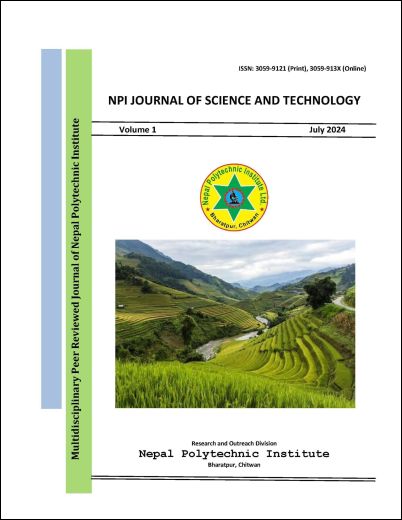Load Flow Analysis and Loss Reduction Activities: A Case Study on Kawasoti 132/33/11 kv Substation
DOI:
https://doi.org/10.3126/npijst.v1i1.68949Keywords:
Load Factor, Load Flow, Load Forecast, OCP, System LossAbstract
This paper deals with the study of energy flow patterns in INPS connected 132KV/ 33KV/11KV Kawasoti Sub-Station. From the monthly data as of April and May 2020, the base load for 30 MVA 132/33 KV transformer is about 12 MW and peak load is around 15 MW. Load forecast of 132/33/11 KV Kawasoti Sub-Station shows that the cumulative load growth percentage is around 70 % and around 8.75% per year. The peak load in 2020 was around 23.53 MW and it would approximately reach 40 MW at the end of fiscal year 2028. Load flow analysis as of 2020 shows total distribution loss was found to be 1.7833 MW when the demand is 23.658 MW at 0.7141 lagging and reactive power loss of 8.907 MVAR is found. Estimated total distribution loss for the year 2028 would be 3.851 MW when the demand is 40.238 MW at 0.76 lagging and reactive power loss of 20.572 MVAR. After the placement of a capacitor bank of 7000 KVar and 5000 Kvar on MV and LV Bus-Bar respectively, the total distribution loss was found to be 0.8695 MW with pay-back period of 1.427 Years for year 2020. After the placement of a capacitor bank of 10000 KVar and 7000 Kvar on MV and LV Bus-Bar respectively, the total distribution loss would be 2.2563 MW with pay-back period of 1.158 Years for forecasted condition. The simulated model, result and analysis are presented in this paper.
Downloads
Downloads
Published
How to Cite
Issue
Section
License
All rights reserved. No part of this publication may be reproduced, distributed, or transmitted in any form or by any means, including photocopying, recording, or other electronic or mechanical methods, without the prior written permission of the publisher, except in the case of brief quotations embodied in critical reviews and certain other non-commercial uses permitted by copyright law.




